Mini Pavlovas are the individual version of traditional Pavlova. A delicate crisp meringue shell with fluffy marshmallow-y insides, they’re adorable, easier to make, and a lot less messy to serve! BONUS: you get the whole thing to yourself. (Wait – is Christmas about generosity and sharing??!!)

Top 3 pavlova tips
-
Measure the egg whites (1/2 cup). Don’t just use “4 eggs”. Because, those selfish darn chickens, they just won’t lay exactly the same size eggs all the time!😤
-
Fresh eggs. Because old eggs don’t fluff as well.
-
Cornflour/cornstarch and vinegar for stabilisation. Just a touch!
-
Make the Pav the night before and cool overnight in the oven. Serve that day for pav perfection.

How to assemble sixteen Mini Pavs in 5 minutes flat
I love a traditional Pav, in all it’s rustic summer beauty. But let’s face it – they are not the easiest to transport. And they are not the best of friends with hot, humid Aussie weather (think – sweaty surface, excessively chewy, weeping sugar, cracking 😭).
And when it comes to messy desserts to serve, pretty sure they take the top spot.
So, this year, avoid the stress and swan in with a platter of mini pavlovas that you assembled within minutes because:
-
you made the pavs last night;
-
you brought whipped cream already whipped (because you now know the Stabilised Whipped Cream secret!); and
-
you brought fruit ready chopped (though mostly berries because…well, no chop 😇).
Oh you domestic goddess, you!! (Or god.)

Difference between pavlova and meringue
Pavlova is a meringue based dessert made with egg white and sugar that is beaten until fluffy (that fluff is called a meringue mixture).
But there’s one big difference between pavlovas and meringues. Both are made from the same meringue mixture. But pavlovas are baked just until the surface has dried out to form a very thin crispy shell, and the inside is soft and marshmallow-y.
Meringues, on the other hand, are crisp all the way through.
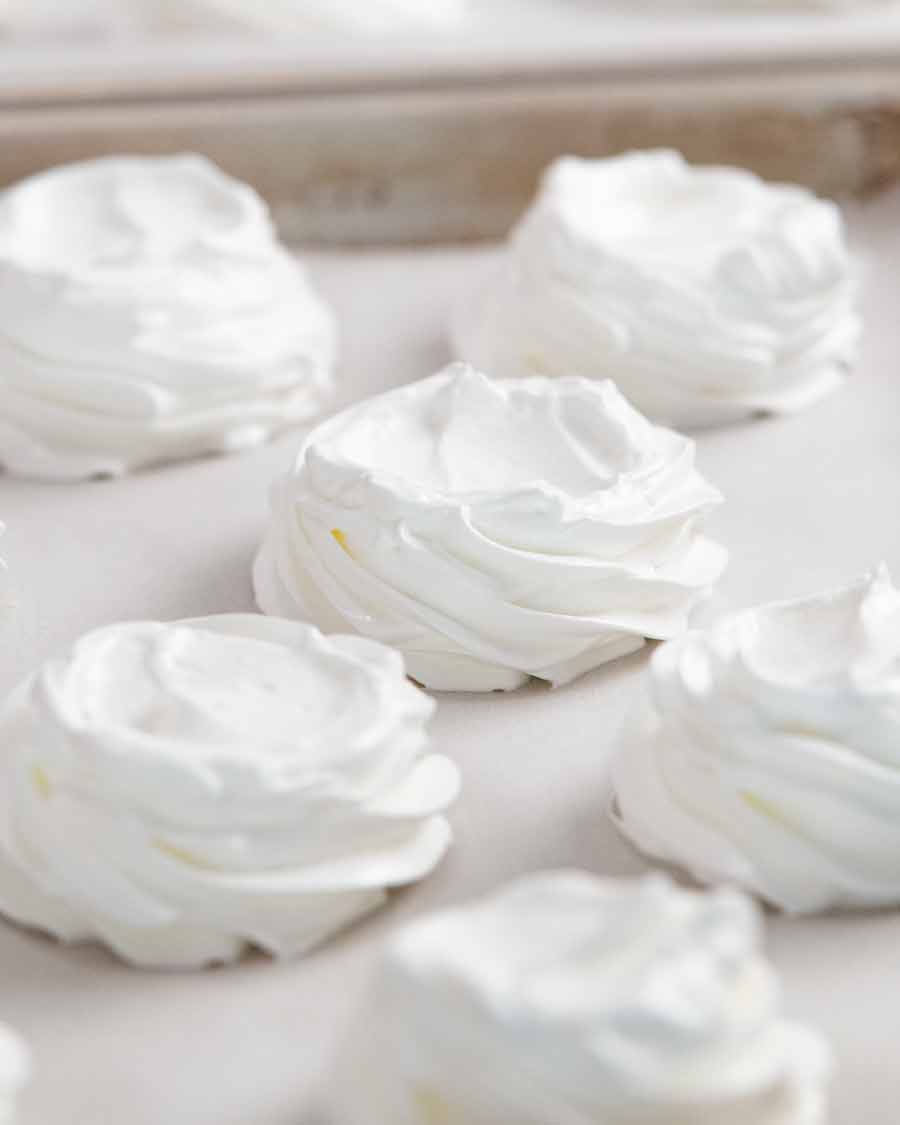
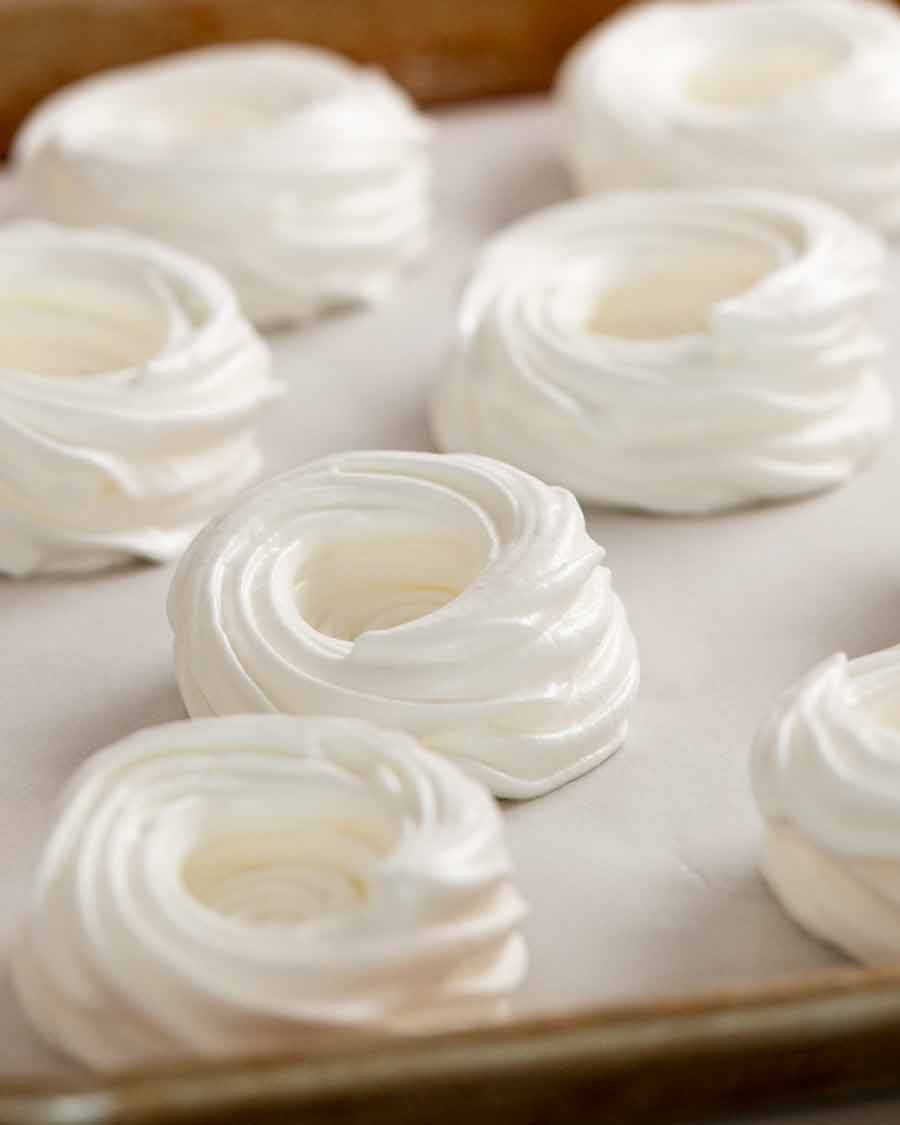
Meringue nests – bonus recipe!
You can actually make meringues (or meringue nests!) using this same recipe, just by baking it longer until it is fully crisp all the way through. Meringues are handy as they have a longer shelf life – as in 5 days. Whereas mini-pavs are best used within 24 hours because they start to get excessively chewy inside (think – stuck in teeth!) and the surface starts to sweat.
I’ve popped directions in the recipe. Bonus recipe!!
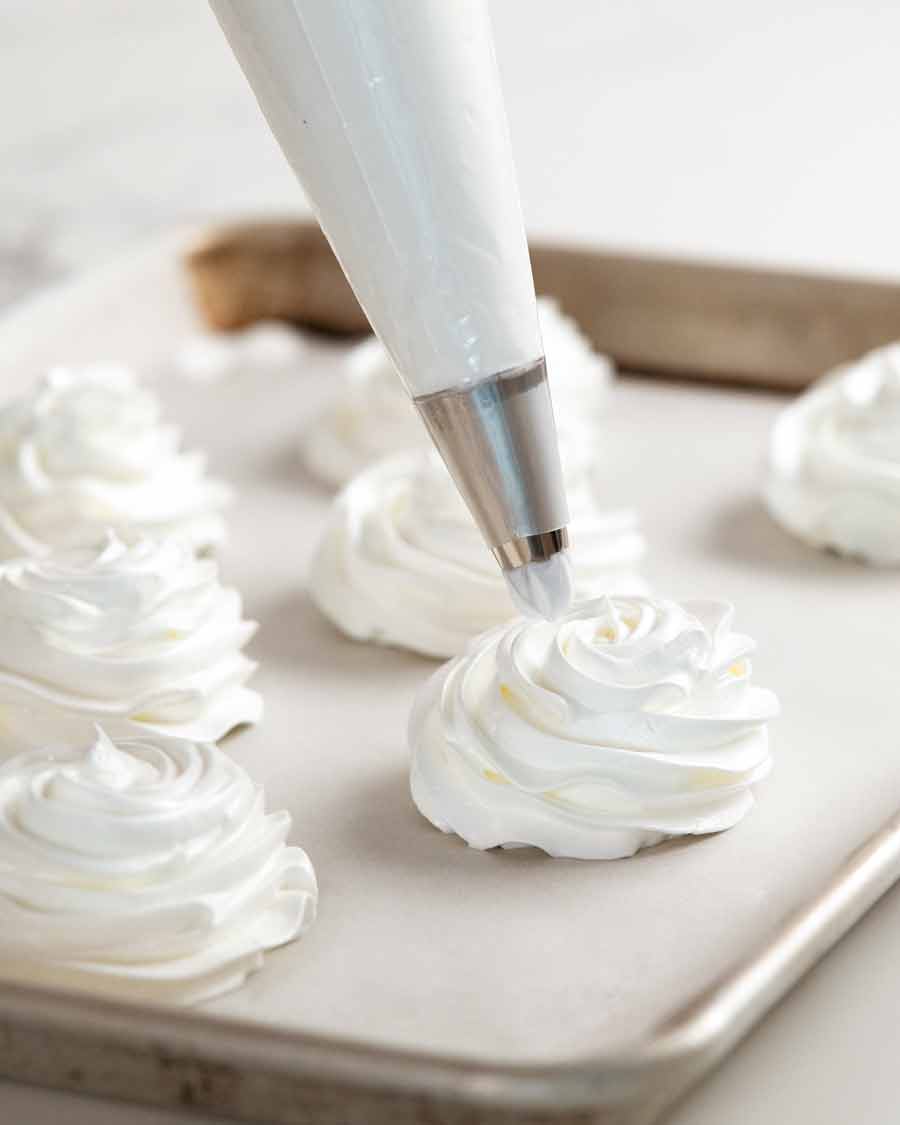
Ingredients for Mini Pavlova
Here’s what you need to make mini pavlovas.
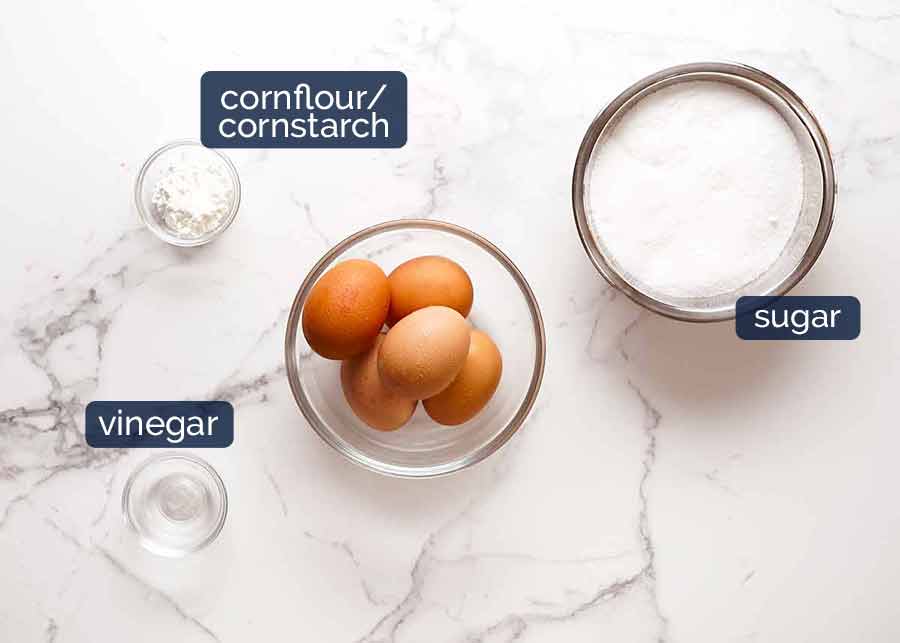
Ordinarily I make notes about each ingredient here in this section. But for pav, I find the commentary flows better as I talk through the steps so you’ll find notes on each ingredient in the How to Make section below.
How to make Mini Pavlova
Key tip – measure your egg whites. Don’t rely on “4 eggs”. Egg sizes vary drastically!!

1. Separate eggs
Use any technique that works for you to separate the eggs. I pass the yolk back and forth between shells so the white slides out. If you’re not confident using this technique, just crack the eggs into your hand and let the whites slip through your fingers. Easy!
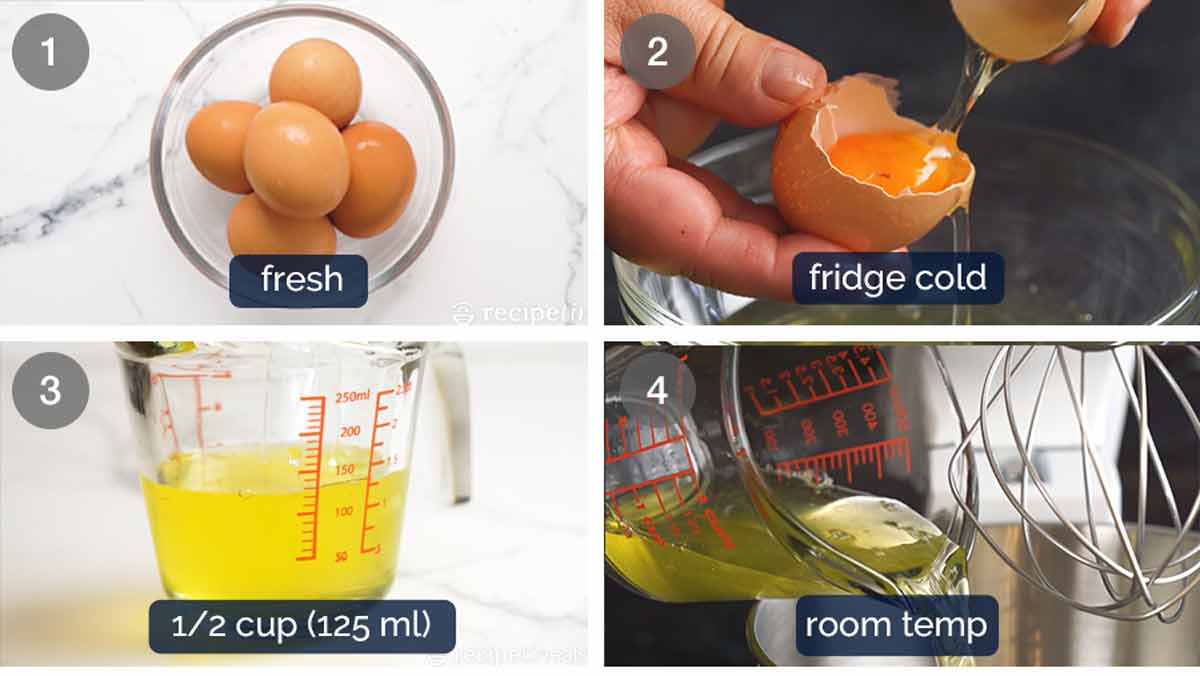
-
Fresh eggs work better – The older the egg, the more liquid the whites become (see demo photos in Poached Eggs). Loose egg whites will not fluff as well when beaten, so the volume of meringue will be less. So try to buy fresh eggs close to the date you’re making the pavlova for the best results;
-
Separate eggs while fridge cold – Whites and yolks separate more easily when cold;
-
Measure, don’t count eggs – The amount of whites in each egg varies depending on size and other variables. It’s too unreliable to just use “5 eggs”! We need 170ml / 2/3 cup of whites. This might be 4, 5 or 6 eggs. Measure out your whites!
-
Whip at room temp – While eggs separate better when cold, they fluff up when they are not fridge cold. So after measuring out the egg whites, leave it on the counter while you prepare the other ingredients, tray etc.
⚠️ Precautionary tip – separate one egg at a time!
If you are a budding chef, I recommend separating the yolks and whites of one egg at a time before adding into measuring jug. This way, you don’t risk ruining an entire batch of egg whites if you accidentally pierce a yolk. This is important because even the slightest drop of egg yolk can prevent the egg whites from becoming fluffy.
2. How to make meringue mixture
Making the meringue mixture for the mini pavs is as simple as 1-2-3:
-
beat
-
beat
-
beat!!!
Oh, and make sure your bowl and whisk are clean and dry. Meringue hates grease and water!
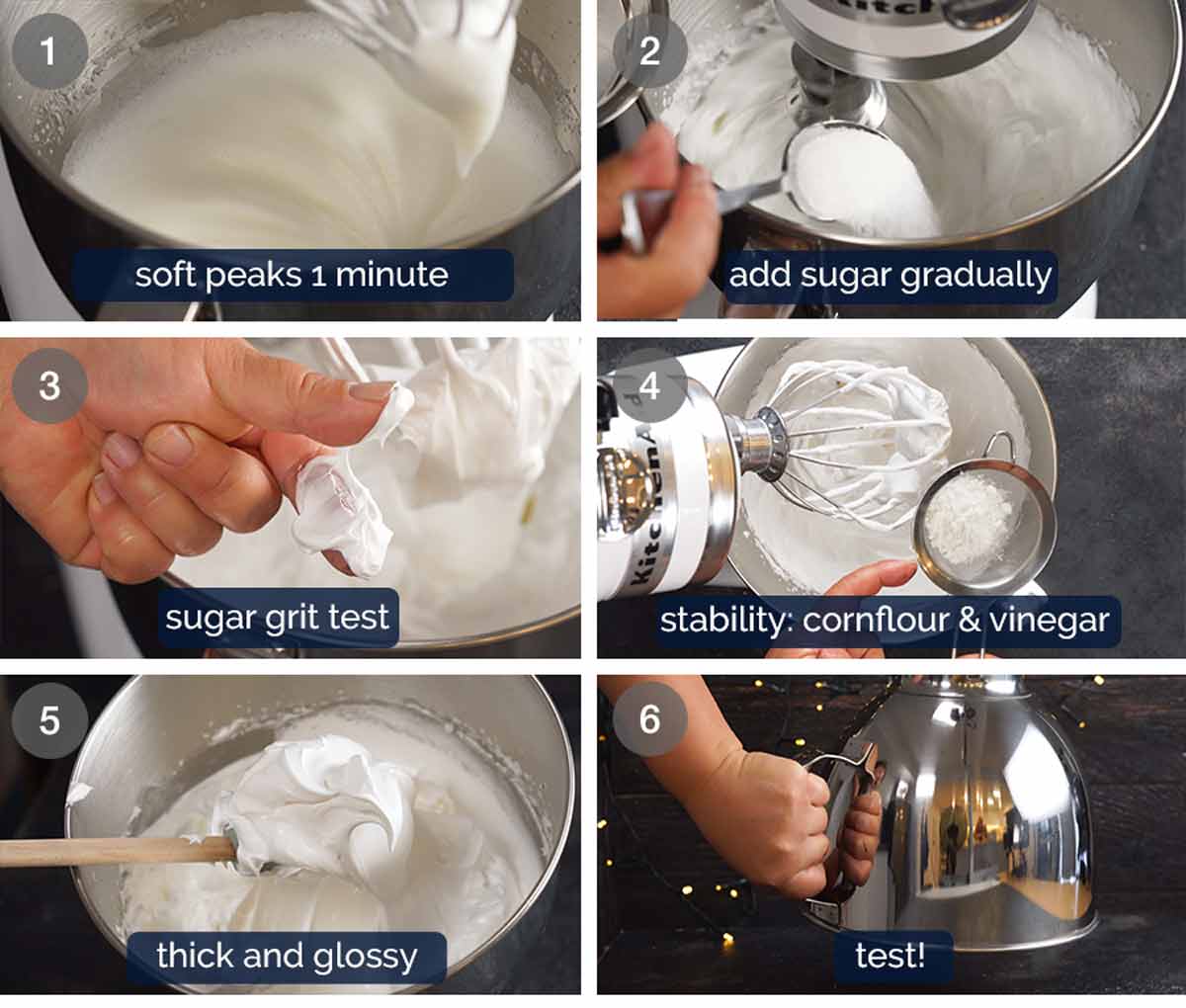
-
Soft peaks – Beat the egg whites for 1 minute on high speed until soft peaks form. If you have a stand mixer with 10 speeds like I do (I have a KitchenAid), use speed 8.
-
Gradually add sugar – With the beater running, add sugar one spoonful at a time, taking around 1 minute. This keeps the whites more aerated and ensures the sugar dissolves, compared with dumping all the sugar in one go.
-
Beat 7 minutes on speed 8. The whites will become thick and glossy, and when you rub between your fingers there should be no sugar grit remaining.
-
Vinegar & cornflour/cornstarch for added stability – Add the vinegar and cornflour then beat for a further 30 seconds. Just a bit of cornflour and vinegar helps make the pavlova more structurally stable and strong so it won’t crack or collapse which is a common problem with a large traditional pavlova. Though less of a risk with mini ones, why risk it when we can take this easy precautionary measure? – desirable for this towering tree!
-
Thick and glossy – The meringue mixture should be thick and glossy, but just to be extra sure, do the ….
-
Upside down test! Flip the bowl upside down and ensure no meringue drops down. If it doesn’t, you know it’s stiff enough for sure and your mini pavs are going to be perfect. If yours drips down, keep beating!
3. Bake
The trick to the perfect pav is to turn the oven off before the surface of the pav is fully crisp so the insides are still marshmallowy. The surface crisps up by leaving the pavs in the turn off oven for 4 hours – or even overnight.
If you bake for too long, the inside will dry out and you’ll end up with meringues (fully crisp all the way through) rather than pavs (which have the signature cloud-like soft insides).
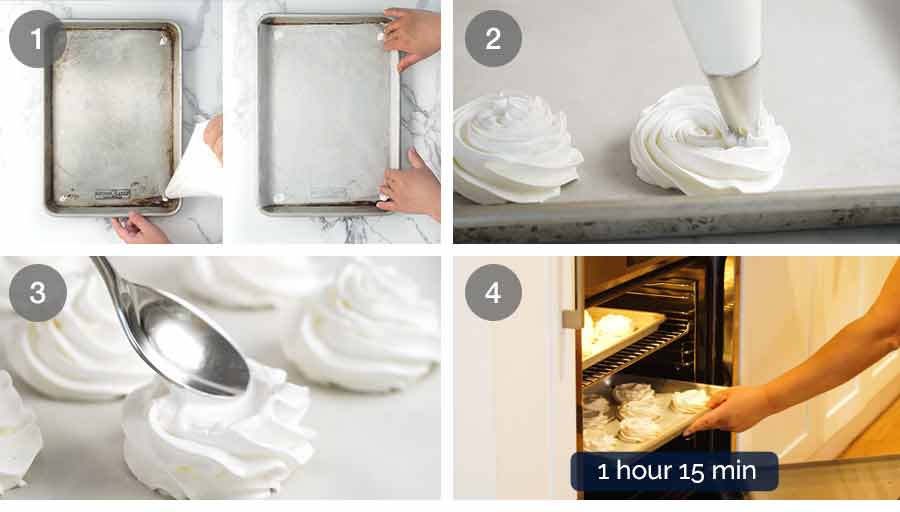
-
Line trays – Dab a bit of the meringue mixture on the corner of 2 trays, then cover with baking paper (parchment). The meringue will glue the paper in place.
-
Pipe mounds – Transfer meringue mixture into a large piping bag fitted with a nozzle of choice (I use Wilton 1M star tip). Pipe 6cm / 2.5″ mounds, 3 – 4cm / 1.25″ tall (14 to 16 pavs).
-
Topping nest – Use the back of a spoon to make a “nest” on the surface for the cream and toppings.
-
Bake 1 hr 15 minutes – Place both trays in the oven and bake for 1 hour 15 minutes at 110°C/225°C (100°C fan) and or until the surface is just about fully dry to touch and not wet or sticky. The pav should still a bit soft when you prod it (GENTLY!!!).
Don’t worry that they seem underdone at this stage. They are. They will finish cooking and drying out when we cool them in the oven in the next step.
Because these pavs are small (remember, we’re making mini pavs here!) we really want to be careful not to take the pavs too far else the inside will dry out (ie no marshmallow centre). Which means you’ll end up with meringues instead of pavs. Not a disaster by any stretch of the imagination, but not what we’re aiming for. We want the marshmallowy insides!

-
Cool in oven 4 hrs to overnight – Turn the oven off then leave the pavs in the oven for 4 hours or even overnight (this is what I usually do). During this step the surface of the pavs will dry up and crisp up, while the middle will stay nice and marshmallowy.
Don’t shortcut or skip this step else you run the risk of the pavs becoming sticky instead of being dry and crisp within mere hours of making the pav. This is a high risk in the humid Aussie weather!
-
Shelf life and storing – Once the pavs are fully cool, pull them out of the oven. They will be a very pale cream colour and delicately crisp on the outside. Handle gently as the shell is fragile.
Store in an airtight container until required. On hot summer days, be sure to store in them in a cool, dry place. In my house, this is the downstair bathroom!
Shelf life – Though pavs will last for a couple of days, they are best served on the day you take them out of the oven after cooling. This is because the delicate shell has a tendency to soften due to the moisture form the marshmallow insides and the inside starts to get quite chewy on the edges (ie stuck in your teeth!). Though actually, this is an appealing characteristic to many!
What I do – I typically bake the night before then leave them overnight in the oven. Pop them straight into a container then use them that day at lunch or dinner.
OK – mini pavs made. Now it’s time to decorate!

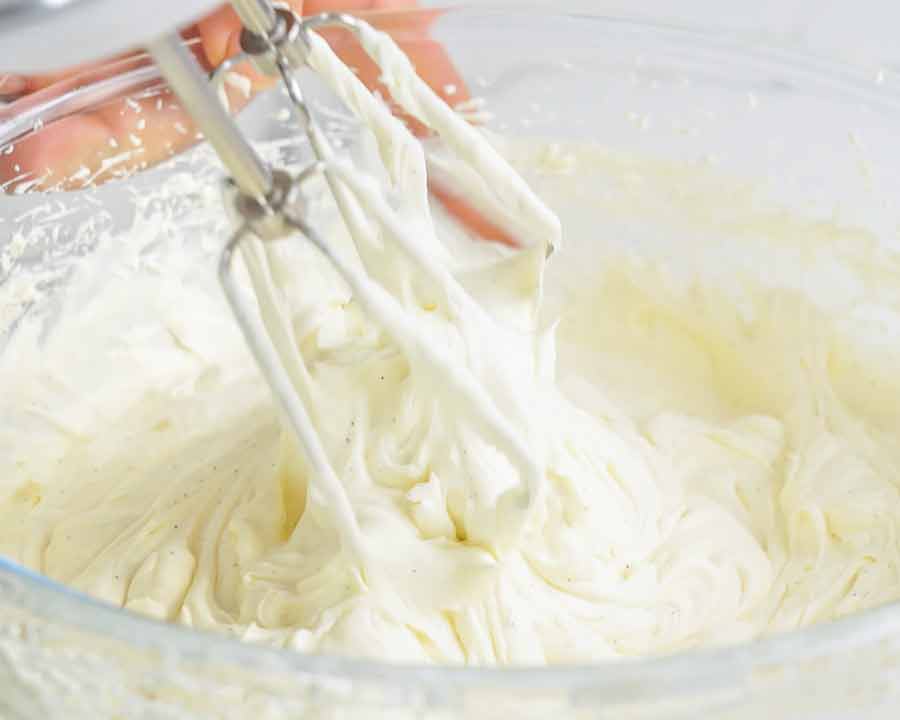
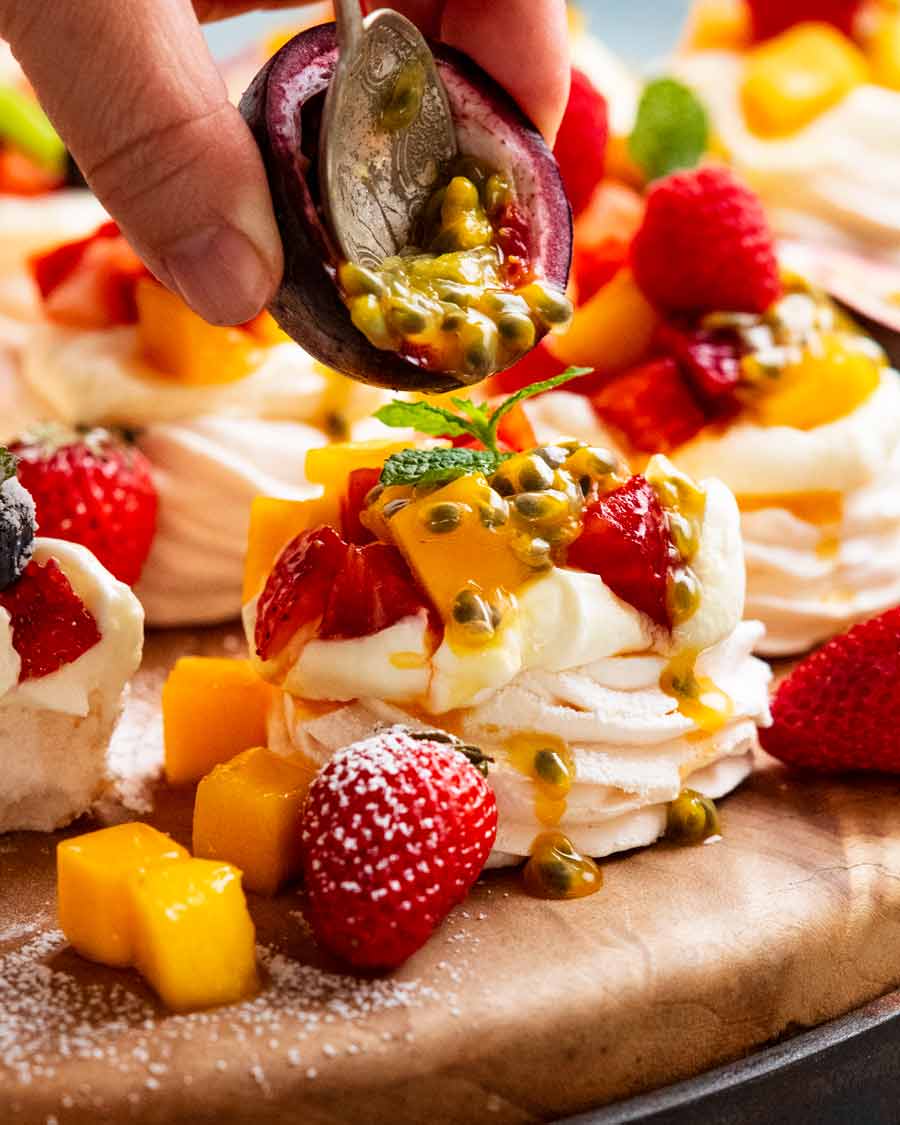
As with traditional pavlovas, the mini version is also best decorated just prior to serving as the cream and juices from fruit will soft the delicate shell of the pav.
Pavlova Toppings
You can really use whatever fruit that takes your fancy, though juicy, soft fruit works best texture-wise with pavlova. Berries, mango and kiwi are common. I can’t imagine crunchy apple pieces on a delicate pav…. someone may have thoughts to the contrary!!
Here are my favourite combinations (I’m so predictable 😂):
-
Whipped cream – A classic and essential pav topping, to act as a glue so you can pile that fruit up on your pav.
Make-ahead stabilised whipped cream – One of my top tips to make your Christmas cooking easier, whip up your cream the day before by making stabilised whipped cream which will stay fluffy and aerated overnight (unlike ordinary whipped cream which deflates and weeps).
-
Berries – Diced strawberries, blueberries and raspberries with a small sprig of mint and dusting of icing sugar. This is my classic.
-
Mango and passionfruit – Diced strawberries and mangoes, finished with a spoonful of passionfruit. A terrific one when mangoes and passionfruit are in season!
-
Kiwi – Also an excellent topping option. Either half moons or diced. Nice touch of green colour,
-
Lemon curd or passionfruit curd – One day I’ll get my lemon and passionfruit curd recipes on my website! I would dollop the curd into the nest then pipe on a swirl of cream.
Hmm. I think that’s pretty much the only combinations I use! I’d love to know if you have any other suggestions. Please share below and I’ll add them to the list! – Nagi x
PS Ah yes, and an important final photo – proof of marshmallow-y insides. Hard to see in photos – but you’ll see quite clearly in the video!



Watch how to make it
Hungry for more? Subscribe to my newsletter and follow along on Facebook, Pinterest and Instagram for all of the latest updates.

Mini Pavlovas
Prep: 25 mins
Cook: 1 hr 30 mins
Cooling: 4 hrs
Dessert
Australian, New Zealand
Recipe video above. Mini Pavs are so cute and so practical! Easier and safer to make and transport, they have a delicate crisp shell and the signature marshmallow centre inside. Top with whipped cream and fruit of choice!
Instructions
Mini Pavlovas:
-
Egg whites – Separate the egg yolks from egg whites while fridge cold (it’s easier). Measure out 1/2 cup (125 ml) egg whites then set aside to come to room temperature for 30 minutes (fluffs better at room temp).
-
Preheat oven to 150°C / 325°F (all oven types, Note 4).
-
Add sugar – In a stand mixer or using an electric beater, beat the egg whites on high for 1 minute. While still beating, add the sugar 1 dessert spoon at a time.
-
Beat 7 minutes – Continue to beat for 7 minutes on high until it’s fluffy, glossy, and there are no sugar grains remaining when you rub a bit between your fingers.
-
Line tray – Dab a bit on the corner of 2 trays then cover with baking paper (parchment).
-
Pipe mounds Transfer meringue mixture into a large piping bag fitted with nozzle of choice (I use Wilton 1M star tip). Pipe 14 to 16 mounds 6cm / 2.5″ mounds about 4 -5 cm / 2″ tall (Measure to top of pointy peak!). Use a spoon to make a “bowl” on the surface to hold cream and fruit. Pavs should end up ~3cm / 1.2″ high.
-
Bake 1 hr 15 min – Place both trays in the oven, immediately turn oven DOWN to 110°C/225°C (100°C fan) and bake for 1 hour 15 minutes or until just dry to touch but still a bit soft. See Note 5 for tips.
-
Cool in oven – Turn oven OFF and leave to fully cool for 4 hours or overnight (I usually do this).
-
Cream – Beat cream ingredients (including mascarpone, if using) in a large bowl on high until soft peaks form (1 minute using a stand mixer, 2 – 3 minutes with hand held beater).
-
Decorate – Just before serving, spoon a big dollop of cream in the nest, top with fruit and dust with icing sugar if using.
Recipe Notes:
- For best results, use fresh eggs
- DO NOT use carton egg whites – it doesn’t fluff up nearly as well
- Separate the egg whites from the yolks while fridge cold (it’s easier to do than with warm eggs)
- Measure out the egg whites until you have 1/2 cup (125 ml), usually 4 to 5 eggs. Why measures? Because it turns out not all eggs are the same size…. So annoying right? Someone needs to have a talk to chickens! 😂
- Leave whites for 30 minutes to take out the fridge chill, cold eggs don’t fluff as well.
2. Vinegar & cornflour/cornstarch – Helps stabilise pav and avoid cracks. For vinegar just use plain white vinegar. Not anything fancy!
3. Mascarpone for stabilising whipped cream – If you add this, it will stabilise the whipped cream so you can whip it the day before and it stays fluffy. Store in a piping bag for ease of storage and use the next day, else in an airtight container but do NOT stir before spooning onto pavs (this will deflate it ia bit). For more information, read here about stabilised whipped cream.
4. Oven temps – Ordinarily fan is 20°C less than standard but for pavs the gap is less because the oven temp is so low (lower temp = smaller gap between fan and standard oven temps).
5. How to check the Pav is cooked – Working quickly, open the oven and touch a pav – it should be JUST dry to touch but still a bit soft ie the shell is very thin. If still wet and sticky, keep baking. The shell will fully dry out and crispy up as it cools in the oven, whilst the centre stays marshmallowy.
6. Storage – Pavs best used on the day they come out of the cooled oven, whether after 4 hours cooling or the next morning as the longer they are stored (especially in hot humid weather) the greater the chance of the surface becoming sticky and the inside becoming chewy. Can be dried out again in the oven but by the time the surface dries out, the inside will probably dry out too so you’ll end up with a meringue (ie crisp all the way through) rather than a marshmallow centre. STILL TASTY!
Store in an airtight container as soon as you take them out of the oven.
Assemble just prior to serving because the cream will soak into the pav.
Life of Dozer
When Dozer was on TV again!!! I was his side kick, just doing a little food demo (Never Ending Meringue Tart!).
It started out very promising, Dozer looking adorably festive with his little elf hat perched on the Dozer Podium next to the cooking bench…..


Oh look, there I am, looking so tall and gazelle-like next to good looking TV hosts – story of my life these days!
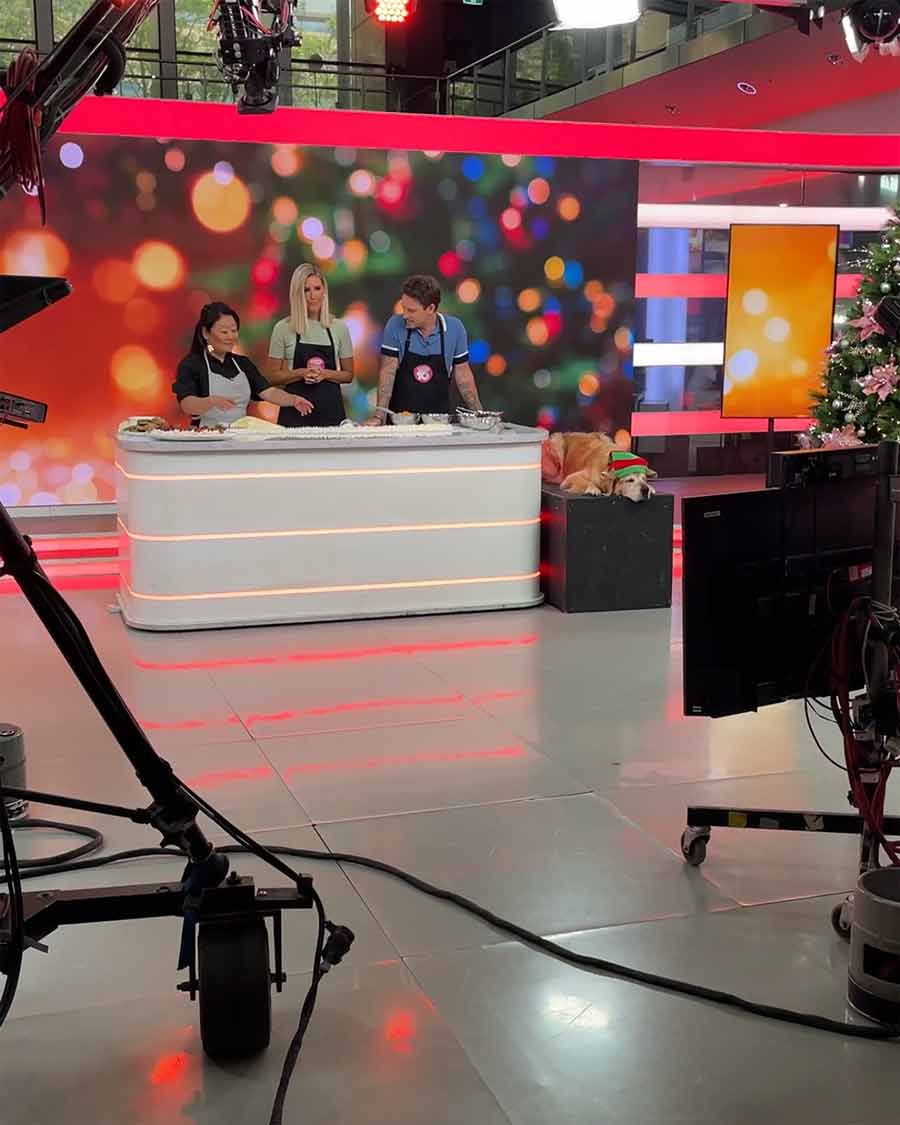
As for Mr Dozer, used to being the star of the show these days, lost interest the moment the cameras swung away from him and turned towards me. And promptly fell asleep. On live television.

Followed by refusing to make his own way off the Dozer Podium (let me remind you, he is 40kg / 80lb!!):

Dozer, you are lucky I love you so darn much. Nobody else would put up with your attitude!!!
And that was the final cookbook TV appearance for 2022. Dozer, you are the best publicity tour wing-mandog any girl could ask for.
Thank you for being a smoochy, cuddly support all those times I was so nervous before stepping out in front of the cameras! Thank you for the laughs with your un-intentional antics, for putting smiles on the face of the TV crew when you waddled up for a pat and your unconditional, unwavering loyalty.
Love you, Dozer! – Nagi x

